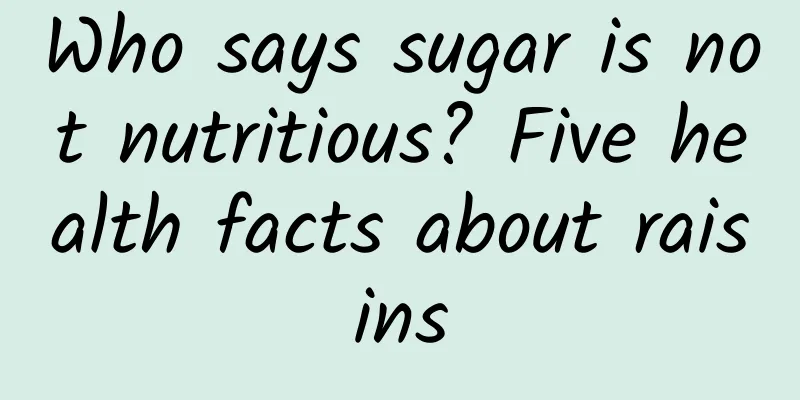Who says sugar is not nutritious? Five health facts about raisins

|
Some people wonder why I like to use raisins in my recipes, especially black raisins. Some people ask: Aren’t raisins just sugar? What is their nutritional value? After being dried, do they still have antioxidant activity? Raisins do contain a lot of sugar because they concentrate the sugar in grapes. However, raisins ≠ sugar. Raisins are dried fruits. They are not within the limits of added sugar. In the dietary guidelines of various countries, they are classified in the same category as fresh fruits. Of course, due to the different water content, one pound of raisins is equivalent to three or four pounds of grapes, so conversion is required. The so-called dried fruits refer to products made from dried fruits without any sugar or fat added during the production process. Such as raisins, dates, dried apricots, dried figs, dried prunes, dried persimmons, dried longans, etc. They are part of the traditional diet and can be eaten directly as snacks or cooked with grains as a healthy alternative to refined sugar, candy, and snacks. Although the drying process will cause the loss of vitamin C, it will not lose minerals and dietary fiber. After removing the water, the minerals such as potassium, magnesium, iron, oligosaccharides, pectin and cellulose in the fruit, as well as most of the antioxidant ingredients, are concentrated. As a representative of dried fruits, it is really time to learn about the health truth about raisins. (The article is quite long, so if you don’t have patience, please just read the title and the highlighted parts.) One of the health truths about raisins: a good source of antioxidants, minerals and dietary fiber. Grapes are rich in polyphenols, some of which are lost during the drying process, but most of them can still be retained in raisins. Because grapes are usually spit out when eaten, and raisins are eaten with the skin, eating raisins can get the nutrients in the skin, including a lot of pectin and cellulose in the skin, including more polyphenol antioxidants than in juice. Studies have found that among common dried fruits, raisins have the highest polyphenol content. Compared by weight, they exceed dried black plums and dried apricots, and even more than most fresh fruits. The polyphenols in raisins include a variety of phenolic acids, flavonoids (quercetin, camphor and rutin), and anthocyanins. Generally speaking, the higher the polyphenol content, the stronger the antioxidant effect. Oxygen radical absorbance capacity (ORAC) assay data from the USDA database show that the total ORAC in seedless raisins is 3037 μmol TE/100 g, which is higher than Fuji apples with skin (2589 μmol TE/100 g), raw broccoli (1352 μmol TE/100 g), and red tomatoes (367 μmol TE/100 g). Seedless raisins are lighter in color, but their antioxidant capacity is still so strong. The database does not provide data on dark raisins, but in theory, dark raisins such as red and black have better antioxidant properties because some anthocyanins are still retained in them (the fact that you can see black means that most of the anthocyanins have not been lost, otherwise it will fade). Raisins are rich in potassium. 100 grams of raisins contain more than 700 mg of potassium. The daily potassium intake for an adult is 2,000 mg. Eating a handful of 25 grams of raisins can provide more than 180 mg of potassium, equivalent to 9% of the reference value. As a snack that can be eaten in small quantities, this is excellent. Raisins eaten with the skin are also a good source of dietary fiber. The dietary fiber content in 100 grams of raisins is 3.3-4.5 grams, which is 6-9 times that of white rice. In the process of making raisins, some of the sucrose and fructose in them will form oligofructose, up to 8% (Olmo-Cunillera A, 2020). Oligofructose is sweet, but the human body cannot digest and absorb it in the small intestine. However, it can be fermented in the large intestine. It is a prebiotic that can adjust intestinal flora and can be regarded as dietary fiber in a broad sense. Compared with light-colored raisins, dark-colored varieties not only have more antioxidants, but also higher dietary fiber and iron content. Therefore, I often recommend using black raisins in nutritional recipes. The second health truth about raisins: It is a medium GI food and does not harm blood sugar. Raisins are a medium-to-low GI food. According to the results of various countries, the GI value of raisin products is between 49 and 69 (Olmo-Cunillera A, 2020). Replacing some staple foods such as rice with raisins does not cause a greater increase in blood sugar. Studies have found that eating raisins three times a week is associated with a lower risk of diabetes compared to drinking juice three times a week. Some researchers asked overweight, obese and diabetic patients to eat a 28-gram bag of dark raisins (84 grams in total, about 270 kcal) three times a day before meals, replacing traditional snacks (biscuits, cookies, etc., containing 300 kcal). After 12 weeks, there was no difference in insulin levels between the two groups of subjects, but the raisin group had significantly lower levels of glycated hemoglobin and postprandial blood glucose, indicating improved insulin sensitivity. Analysis of the data of diabetic patients showed that the postprandial blood glucose response in the raisin group was significantly reduced, and fasting blood glucose and HbA1c also tended to decrease (Anderson et al, 2014). Experiments conducted on healthy people found that when half of the white rice was replaced with raisins containing 25 grams of carbohydrates, the postprandial blood sugar response did not increase, and the peak blood sugar concentration and blood sugar fluctuation range were comparable to those of rice (Zhu et al, 2018). The third health truth about raisins: good for blood pressure and blood lipids. Because raisins are a good source of potassium, magnesium and a variety of antioxidants, and are also rich in oligosaccharides and pectin, they are good for heart health when eaten in moderation. A survey found that eating at least 160 grams of raisins per week significantly reduced the risk of high blood pressure (Borgi L, 2016). Studies have shown that replacing snacks such as cookies and cakes with raisins is more conducive to controlling blood pressure. Researchers conducted a 12-week dietary intervention on 46 patients with prehypertension, providing raisins (containing 220 mg of potassium) three times a day. Blood pressure was measured at the 4th, 8th, and 12th weeks, and it was found that the systolic blood pressure of the raisin group decreased by 4.8% to 7.2%, and the diastolic blood pressure decreased by 2.5% to 6.4% (Bay et al, 2012). Another study had 34 subjects eat 160 grams of raisins every day for 6 weeks, with or without daily walking exercise. Compared with those who did not eat raisins, total cholesterol decreased significantly, and low-density lipoprotein cholesterol (LDL-c) also decreased (Puglisi MJ, 2009). The fourth health truth about raisins: Proper consumption will not cause obesity. A survey found that people who consumed more than 20g of mixed dried fruit per day had higher calorie intake, but significantly lower average weight, BMI and waist circumference than those who consumed less dried fruit. After eliminating various confounding factors, it was found that people who consumed more dried fruit had higher intakes of vitamins and minerals, richer dietary fiber, and lower numbers and proportions of overweight, obese and abdominal obesity than those who did not eat dried fruit (Keast DR, 2011). After consuming extra dried fruits, the calories are higher and the carbohydrate energy supply ratio is also higher, so why is it not easy to gain weight? This may be because after eating sweet dried fruits, people no longer want to eat snacks, biscuits and desserts. Compared with these foods, dried fruits have higher nutrient density and more healthy ingredients. Just like the survey found that people who eat nuts as snacks in moderation are not fatter than those who do not eat nuts. The fifth health truth about raisins: they are not as harmful to teeth as sweets. Dental research has found that eating a handful of raisins every day does not damage your teeth as much as eating sweets, as long as you brush your teeth and rinse your mouth normally. Raisins contain very little sucrose, and fructose and glucose only stay on the tooth surface for a short time. The antioxidant components in them also have a slight antibacterial effect. Therefore, the pH value on the tooth surface does not drop much after eating raisins, and does not reach the level of damaging the tooth enamel. Of course, every kind of food has its own reasonable share. If you eat too much dried fruit without replacing other carbohydrate foods, or eat less other foods and only eat a lot of raisins, it is also not conducive to nutritional balance, and will make you fat or harm your health. I think it can be said that without the premise of nutritional balance, talking about calories, carbohydrates, fats, deifying a certain natural food, or demonizing a certain natural food, it is all hooliganism... How many raisins are good to eat? According to the literature, eating 160 grams per week will have a health effect, which is an average of 23 grams per day. If you can eat 200 grams of fruit per day, you can eat about 25 grams. If you eat less fruit on a daily basis, you can increase it to 30-40 grams. Of course, this amount includes all kinds of dried fruits, not just raisins. Dates, dried apricots, dried figs, dried blueberries, dried persimmons, dried wolfberries, etc. should also be included. References: 1Wang Linlin, Fan Zhihong, Dong Yang. Research progress on dried fruits and human health. Chinese Food and Nutrition, 2020, 26(6): 63-67 2 Olmo-Cunillera A, Escobar-Avello D, Pérez AJ, et al. Is Eating Raisins Healthy? Nutrients, 2020, 12, 54. 3 Keast DR, O'Neil CE, Jones J M. Dried fruit consumption is associated with improved diet quality and reduced obesity in US adults: National Health and Nutrition Examination Survey, 1999-2004. Nutrition Research, 2011, 31 (6): 460-467. 4 Hernándezalonso P, Camachobarcia L, Bulló M, et al. Nuts and dried fruits: an update of their beneficial effects on type 2 diabetes. Nutrients, 2017, 9(7): 673-706. 5 Borgi L, Muraki I, Satija A, et al. Fruit and vegetable consumption and the incidence of hypertension in three prospective cohort studies. Hypertension 2016, 67, 288–293. 6 Bays HE, Schmitz K, Christian A, et al. Raisins and blood pressure: a randomized, controlled trial. Journal of the American College of Cardiology, 2012, 59(13): E1721. 7 Puglisi, MJ; Mutungi, G.; Brun, PJ; McGrane, MM; Labonte, C.; Volek, JS; Fernandez, ML Raisins and walking alter appetite hormones and plasma lipids by modifications in lipoprotein metabolism and up-regulation of the low-density lipoprotein receptor. Metabolism 2009, 58, 120–128. 8 Anderson JW, Weiter KM, Christian AL, et al. Raisins compared with other snack effects on glycemia and blood pressure: a randomized, controlled trial. Postgraduate Medicine, 2014, 126(1): 37-43. 9 Ruixin Zhu, Zhihong Fan*, Yang Dong, Manman Liu, Linlin Wang, Haikun Pan. Postprandial Glycaemic Responses of Dried Fruit-Containing Meals in Healthy Adults: Results from a Randomized Trial. Nutrients, 2018, 10, 694 Source: Fan Zhihong_Original Nutrition Information |
<<: Super-large bacteria that can be seen without a microscope!
Recommend
A sudden earthquake of magnitude 4.1 occurred in Huizhou, Guangdong Province in the early morning! Please master the golden 12 seconds for self-rescue
According to the official measurement of China Ea...
How does information flow advertising accurately target users?
With the vigorous development of mobile Internet ...
Short video script writing skills and templates!
Although a short video is only 60 seconds long, e...
7 Swift gotchas and how to avoid them
[[163025]] Swift is accomplishing an amazing feat...
What exactly is the mysterious creature “Water Monkey”?
In our country, various versions of the "wat...
How to track friends’ location using WeChat mini-programs?
How to track friends’ location using WeChat mini ...
What are WeChat Mall, WeChat Mini Program, and WeChat Store? What are the differences?
Tencent has many products. Take the "WeChat A...
Why Arm's ban on Huawei will not have any substantial effect?
Huawei can rely on its existing ARMv8 licenses fo...
Analysis of competing products for 618 events on Tmall, JD.com and others!
This article will analyze the 618 activities of o...
How to do corporate brand planning?
There have been a lot of hot topics these days, f...
Yu Chengdong visits BAIC, and the company officially confirms that the Arcfox HBT equipped with Huawei solution will be delivered within this year
Recently, Huawei Consumer BG CEO Yu Chengdong, Gl...
Xiaomi said that whoever wins the hearts of the people will win the world, and those young people who paid real money are not happy.
Young people will influence the future consumer m...
The evolution of programmer communication in the post-IT era
[[154418]] Every programmer wants to change the w...
The Evil King Chases His Wife, the Useless Lady, Free Full Text, The Evil King Chases His Wife, Nangong Luoluo, Gives Birth!
She, the golden killer of the 21st century, was w...
Severe toothache is unbearable! Do taking medicine or chewing peppercorns really work? Huaxi doctors: Recommend this treatment method!
Toothache, the listener is sad and sheds tears Ho...









